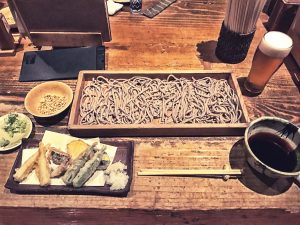This article first appeared on The Mission Podcasts Medium Blog
It’s been about 25 years since the first NetScape browser hit the market. It’s truly amazing how far we’ve progressed in terms of our digital life. Despite the progress of what we can do online, many companies still struggle with how they can make digital experiences more like the physical world.
A good place to start is to explore a tradition that’s over 2,000 years old.
I’ve been a student of Japanese culture for most of my life. I minored in Japanese in college, studied abroad in Tokyo, and spent much of my early career there. My first job out of college was working for Toshiba as one of their first non-Japanese staff members — and almost every company I’ve worked for since has had a connection to the country.
One aspect of Japanese culture that I believe has such an important message for business — and all social interactions — in any country is the concept of Omotenashi (おもてなし). While it is often translated as “Japanese hospitality,” a more accurate interpretation is “other awareness.” It’s a way of thinking about our interactions with others that starts with a greater understanding of the other person’s needs.
Omotenashi can, and should, be applied to all aspects of daily life, but it’s particularly instructive for companies thinking about Digital Transformation. That’s because in today’s hyper-competitive digital world, a personalized customer experience is more important than ever. So incorporating the mindset of omotenashi into your business practice can help you forge meaningful connections with customers and keep them coming back.
Here’s how to get started:
Omotenashi is all about anticipating people’s needs without them having to say anything.
Close your eyes. Think of the best shopping, restaurant, or hotel experience you’ve had. It likely involved the other person anticipating exactly what you needed — maybe before you even realized it yourself. Ok, you can open your eyes now.
For example, I’m left-handed, which leads to many awkward dining situations when I’m seated next to a righty. But in just about any restaurant in Japan, as soon as the waitstaff detects my left-handedness, the entire dining experience is catered to my left-handed orientation.
Here’s a play-by-play of how this worked during my recent business trip to Japan when I visited a wonderful soba noodle restaurant. In this first picture, you can see how the ohashi (chopsticks) are typically placed — with the holder on the left side (in this case a peanut serves as the holder). Since 99.99% of people in Japan pick up the ohashi with their right hand to eat, this orientation is the norm.

Once I sat down, I reversed the direction so that the peanut was on the right, which indicated, “I’m picking the ohashi up with my left hand.”

Without saying anything, the waitstaff noticed this, and when my meal was ready, everything was positioned for a lefty.

Note that the sauce for dipping the soba noodles is on the right side by my right hand. Since I will be picking up noodles with my dominant (in this case left) hand, the dipping bowl will be in my right hand to dip the noodles in. Also, the tempura is placed by my left hand, so I can pick those up easily without having to cross over the full meal placement to pick them up on the right side (where they’d typically be if I were right-handed).
I admit, I geek about about things like these. But it was such a subtle and everyday example of omotenashi, that it in fact compelled me to write this article.
The key point is, I never have to request this service. It just happened as a result of the waitstaff carefully observing my behavior.
I encourage other business leaders to apply omotenashi and become more aware of others’ needs. If you’re overly concerned only with your business plans and goals, you may miss opportunities to build meaningful business relationships — and provide an experience your team members and customers will truly value.
Omotenashi can help companies cater more personal interactions with online customers.
We often hear, “The customer is always right.” This implies a customer makes a statement, and you are reacting to fulfill it.
But in the online space, the customer can’t always tell you what they need — especially with non-verbal or visual signals. Rather, they show you their desires through their clicks and other behavioral aspects during their time on your site or app that send subtle signals of their intent and desires.
That’s why the most customer-centric companies, especially in Japan (many of whom are in fact LiftIgniter customers), are focused on recreating the experience of omotenashi that a customer gets in real life in a store or restaurant.
One thing we’ve learned is that Artificial Intelligence (AI) can actually help companies be more empathetic to their customers. For example, several LiftIgniter customers now use an AI-powered virtual agent to mimic the experience from a live service agent.
Closer to my home, LA-based resale marketplace Tradesy uses LiftIgniter to not only customize product recommendations, but also to create a virtual store experience for a brand dynamically based on the signals picked up by our AI engine. So, if we detect signals that they are currently interested in a specific brand, the site will dynamically adjust to that brand — it’s like having a virtual Ralph Lauren or Gucci showroom right in front of you as you click.
Machine learning can mimic omotenashi by facilitating observation and empathy to create a highly-tailored and memorable online customer experience.
Being “other aware” is not only a commercial construct, but a way of life.
At its core, omotenashi is about service. But that doesn’t necessarily mean that it’s only applicable to customer relationships and sales. Managers can also use this other-aware mindset to lead their teams with compassion, empathy, and understanding.
Omotenashi has helped me navigate interpersonal business relationships in all sorts of ways.
For example, after an argument or disagreement with a colleague, if I take a few minutes to consider their perspective and needs, I’m able to resolve the situation more quickly and effectively. It’s just about seeing things from their perspective.
As part of my studies in Japan, I learned a lot about Japanese Kanji characters. The Japanese kanji characters that make up the word omotenashi are “motsu,” (持) which means to have or hold, and “naru,” (成) which means to evolve or grow. I believe these two characters give the true meaning of the term: the holding or internalizing of what the other person needs, and through that, becoming something better — both as an individual and as a society.
As you continue to practice putting yourself in someone else’s shoes, eventually you won’t have to think about the meaning behind omotenashi at all. It will become internalized and effortless — and your customers will surely take note.

